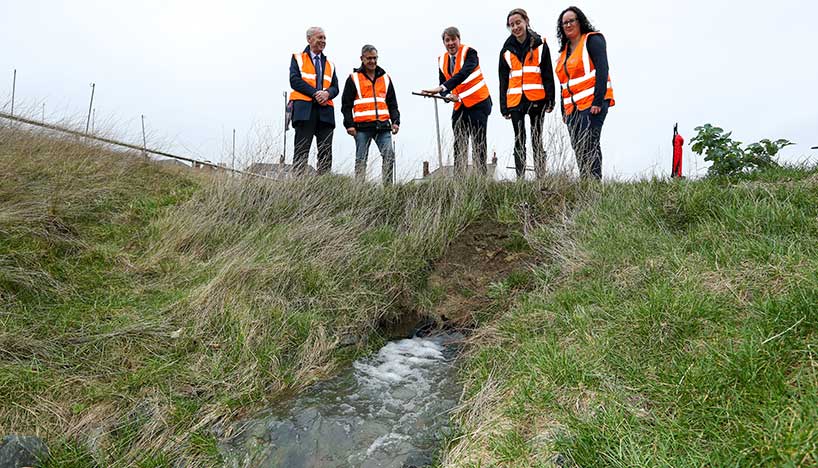NGIF
Holding back the flood
Published on: 24 January 2020
The UK’s largest testbed for sustainable drainage systems is providing a blueprint for how our cities should be designed in the future in order to reduce the risk of flooding.
Opened today by The Rt Hon Chris Skidmore, Minister of State for Universities, Science, Research and Innovation, the UKCRIC National Green Infrastructure Facility will allow engineers to test the performance of new technologies that can slow the flow of water in the event of extreme rainfall and reduce the risk of flooding in cities.
Designed by engineers at Newcastle University and funded by the Engineering and Physical Sciences Research Council (EPSRC) part of UK Research and Innovation, the facility integrates a range of naturally engineered systems such as green roofs and rain gardens together with a full-scale swale which is fitted with a series of ‘leaky barriers’ designed to hold back floodwaters. These include a range of slotted barriers that can be modified to replicate natural conditions, alongside a wetland area.

Fitted with a network of sensors
Situated in the heart of Newcastle, the swale is fitted with a network of sensors and cameras to monitor flow, water levels, soil moisture, rainfall and other meteorological conditions.
This data is then fed into Newcastle University’s Urban Observatory, the UK’s largest set of real-time open data, and will be used to inform future flood management and help policy makers and emergency services make decisions in real time if, and when, flooding occurs in the future.
Based on the Newcastle Helix site - a 24 acre ‘living laboratory’ and innovation hub – the Facility is the latest addition to Newcastle’s Blue-Green City initiative.
Launching the project, Mr Skidmore said “This new facility at Newcastle University will put the UK at the forefront of innovation in flood defences, helping us reduce the damage we have seen too often across the country.
“Our approach to climate change must not just be reducing emissions, but also to tackle its impacts like milder, wetter winters and rising sea levels, so we can save our planet and protect it for future generations.”
Reducing the risk of future flooding
Co-director of the National Green Infrastructure Facility (NGIF) Dr Claire Walsh, a lecturer in Green Infrastructure at Newcastle University, said the aim was to use this site as a demonstrator to help protect other urban areas from flooding.
“The UK has seen an increase in the number of extreme weather events over the past decade and we have seen the devastation and distress that flash flooding causes.
“Naturally-engineered schemes should work hand in hand with flood defences. In this way, we can disperse the water and reduce the flood risk rather than simply moving the problem downstream.
“At Newcastle University we are working on designing a number of natural flood management schemes to help our urban environment cope with a changing climate and future development pressures.”
Co-director Dr Ross Stirling, a lecturer in Geotechnical Engineering at Newcastle University, added:
“Through the NGIF, we are not only considering the benefit that ‘green infrastructure’ can provide in terms of reducing flood risk, but also looking at its economic, social and environmental benefits.
“We are exploring how green spaces may be exploited for renewable heat generation, adding value beyond their role in surface water management. We are investigating the treatment of polluted runoff from our streets and the carbon capture potential of green infrastructure. And we are considering how these approaches compare with traditional methods such as pipes by evaluating the cost of constructing these features and maintenance regimes over time.
“Flooding can be extremely costly from both an economical and emotional perspective and investment in mitigating floods upfront using green infrastructure can bring a wide range of benefits.”

70 years of water research at Newcastle University
The National Green Infrastructure Facility builds on 70 years of water research at Newcastle University and its launch coincides with a major international water conference to mark the occasion.
Previous research has focussed primarily on rural communities, working with the natural landscape to try to slow down the flow of water and prevent the sort of devastation that was experienced in Morpeth, Northumberland, in 2008.
Among these projects was the ‘Kerplunk’ system – a 60m ‘ladder’ of criss-crossing logs carefully pinned into the banks of Slaty Sike, one of the tributaries of Haltwhistle Burn.
Designed to slow the flow of water during periods of intense rainfall, the system works by trapping sediments and rocks just like the marbles in a game of Kerplunk.
Dr Eleanor Starkey, who led the research with Dr Paul Quinn, explains:
“Slaty Sike is a good example of a catchment that copes well under normal weather conditions but when the area is hit by bigger storms we see a rapid flow of water through the catchment, washing debris and stones into the Burn. This causes significant flooding problems for the communities and business owners downstream.
“Similar to the swale we are opening today, the Kerplunk system is designed to slow that flow and hold back the debris, improving water quality lower down and also reducing the risk of flash flooding in the town which can be caused by the build-up of large debris, particularly under bridges.
“In a city we couldn’t create something of this scale, so instead we need to engineer a range of solutions which bridge the gap between urban and rural flood risk. Just because we are working in cities it doesn’t mean that we can’t work with nature too.
“And there’s a wellbeing aspect too. Concrete flood defences have a role to play, but the infrastructure we are creating improves the environment for people and wildlife and creates a place for engagement and learning – protecting our cities and improving them at the same time.”



